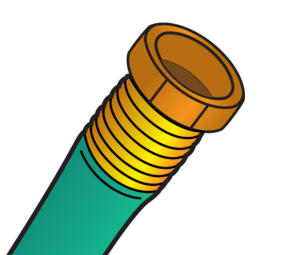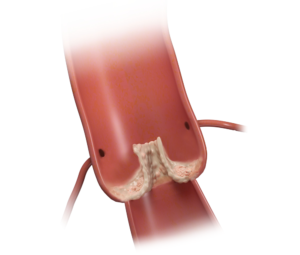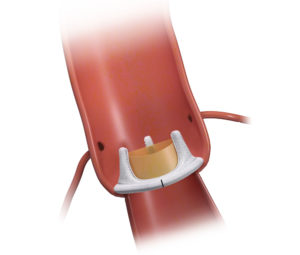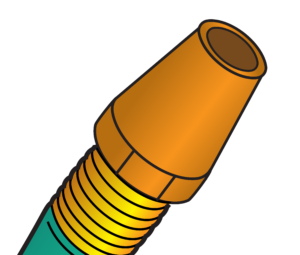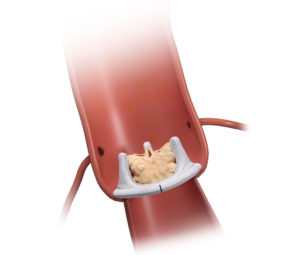
Tissue valves, also called “bioprosthetic valves”, are made with animal tissue, typically pig or cow. These valves do not commonly require lifelong blood thinner, but their biggest downside is their limited durability.
What is Structural Valve Deterioration (SVD)?
Over time, tissue valves begin to break down, leak, or become too stiff and too small again, reintroducing symptoms of valve stenosis and regurgitation by a condition called Structural Valve Deterioration (SVD).
- Only tissue valves develop SVD.1
- The younger a patient is when they get a tissue valve, the faster they will experience the onset of SVD. 2
What does SVD
mean to me?
The reality is that tissue valve patients experience valve disease all over again and it could be years between starting to experience symptoms and actually having another surgery, if the patient is even a candidate for reoperation.
- SVD causes patients to feel tired and short of breath as their new aortic tissue valve deteriorates.2-4
- There is no known medical therapy to prevent or treat SVD.
What are my options with SVD?
Some tissue valves can begin to fail after only 6 years and may require reoperation as early as 8 years after implant.5-6 A Valve-in-Valve procedure may be an option, but there is no long-term data on patient survival or valve durability. Also, some patients with SVD from tissue valves are inoperable.
- Up to 17% of patients who develop SVD from tissue valves are not candidates for another operation.7-8
What is Structural Valve Deterioration (SVD)?
Over time, tissue valves begin to break down, leak, or become too stiff and too small again, reintroducing symptoms of valve stenosis and regurgitation by a condition called Structural Valve Deterioration (SVD).
- Only tissue valves develop SVD.1
- The younger a patient is when they get a tissue valve, the faster they will experience the onset of SVD. 2
What does SVD
mean to me?
The reality is that tissue valve patients experience valve disease all over again and it could be years between starting to experience symptoms and actually having another surgery, if the patient is even a candidate for reoperation.
- SVD causes patients to feel tired and short of breath as their new aortic tissue valve deteriorates.2-4
- There is no known medical therapy to prevent or treat SVD.
What are my options with SVD?
Some tissue valves can begin to fail after only 6 years and may require reoperation as early as 8 years after implant.5-6 A Valve-in-Valve procedure may be an option, but there is no long-term data on patient survival or valve durability. Also, some patients with SVD from tissue valves are inoperable.
- Up to 17% of patients who develop SVD from tissue valves are not candidates for another operation.7-8
What is Structural Valve Deterioration (SVD)?
Over time, tissue valves begin to break down, leak, or become too stiff and too small again, reintroducing symptoms of valve stenosis and regurgitation by a condition called Structural Valve Deterioration (SVD).
- Only tissue valves develop SVD.1
- The younger a patient is when they get a tissue valve, the faster they will experience the onset of SVD. 2
What does SVD
mean to me?
The reality is that tissue valve patients experience valve disease all over again and it could be years between starting to experience symptoms and actually having another surgery, if the patient is even a candidate for reoperation.
- SVD causes patients to feel tired and short of breath as their new aortic tissue valve deteriorates.2-4
- There is no known medical therapy to prevent or treat SVD.
What are my options with SVD?
Some tissue valves can begin to fail after only 6 years and may require reoperation as early as 8 years after implant.5-6 A Valve-in-Valve procedure may be an option, but there is no long-term data on patient survival or valve durability. Also, some patients with SVD from tissue valves are inoperable.
- Up to 17% of patients who develop SVD from tissue valves are not candidates for another operation.7-8
The images below show the stages of stenosis, or calcification, in an aortic valve and how the opening of the valve gets smaller with each procedure, building up the pressure within the heart making it difficult to pump blood to the rest of the body. This is very similar to a water hose and the higher pressure that builds up when a smaller nozzle head is attached to the hose opening, resulting in less and less water flowing from the hose.
Healthy Native Valve
Normal, healthy aortic valve.
Calcified Native Valve
Patient’s own aortic valve becomes diseased and calcified, needing to be replaced.
Healthy Tissue Valve
Patient has tissue valve implanted for surgical aortic valve replacement. This valve can start to fail after only
6 years.5
Calcified Tissue Valve
Tissue valve develops SVD and requires reoperation as early as 8 years after implant, if the patient is a candidate.8
Valve-in-Valve (ViV)
Transcatheter valve is inserted inside the first failed tissue valve, this is a ViV procedure. What happens next since there is no long-term data on ViV?


